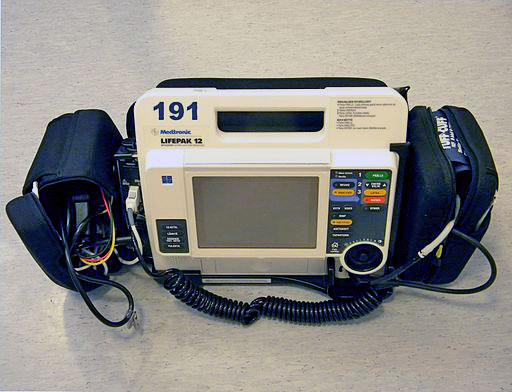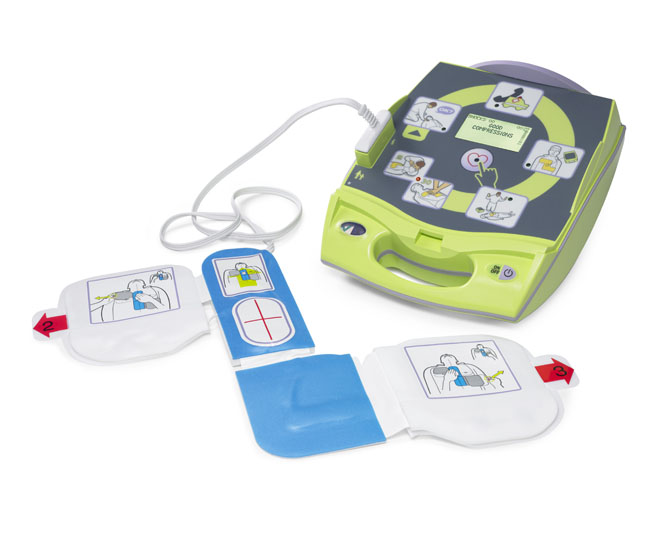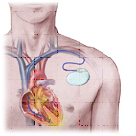Types of Defibrillators
There are four major categories of defibrillators:
Advanced Life Support (ALS) Units

ALS units can be used with either paddles or electrodes, though the trend today is to use the defibrillation electrode as it is much safer for the rescuer and delivers the shock more uniformly and effectively. Since 2005, the American Heart Association gave pads over paddles a Class IIa recommendation.1
Self-adhesive monitor/defibrillator electrode pads are as effective as gel pads or paste (LOE 3), and they can be placed before cardiac arrest to allow for monitoring and then rapid administration of a shock when necessary. Consequently, self-adhesive pads should be used routinely instead of standard paddles (Class IIa; LOE 2, 4).1
Advanced Monitoring Parameters
Beyond the ability to deliver a shock, ALS defibrillators are often outfitted with a number of parameters to aid rescuers.
Most in-hospital ALS units will have an external pacing capability to allow external pacing of bradycardiac rhythms.
Many will also offer SpO2, a means to monitor the oxygenation level of the patient via an external sensor.
Other options available on ALS defibrillators include:
- Capnography to monitor carbon dioxide levels. Continual waveform capnography now carries a Class 1 recommendation for monitoring ET tube placement by the AHA.2
- Non-Invasive Blood Pressure (NIBP) to automatically measure the patient’s blood pressure via a blood pressure cuff.
- Invasive Blood Pressure (IBP) which is used mainly during critical care transportation of patients with invasive lines, either during transport within the hospital to different departments or via ambulance or aircraft.
Temperature to monitor patient temperature.
- 12-lead ECG, widely used by paramedics in the field, allows for rapid identification and classification of STEMI (ST-elevated myocardial infarction). The ECG reading can be transmitted to receiving hospitals and alert cardiology teams that a patient requiring intervention is on the way, dramatically reducing door-to-balloon time.
- CPR support: A growing number of ALS defibrillators now provide support for cardiac compressions. It has become exceedingly clear that good CPR is vital to improving resuscitation outcomes; it has also been determined that delivering good consistent CPR is difficult – even for highly trained professionals. Therefore, there is growing acceptance of the need for defibrillation products to not only be capable of delivering a shock, but also capable of assisting with delivery of optimal circulatory support.
Automatic External Defibrillators (AEDs)

 Implantable Cardioverter Defibrillators (ICDs)
Implantable Cardioverter Defibrillators (ICDs)
These units are implanted directly into the patient’s chest and designed to protect those patients at high risk of sudden death. Generally, these are patients who have either a known medical condition that puts them at risk, or have actually experienced an episode of VF/VT. These products are beyond the scope of this website, and an in-depth discussion of these products can be found at the American Heart Association website.
Wearable Defibrillators

Wearable defibrillators are care options for patients at risk of sudden cardiac death. These are discussed more fully in the wearable defibrillator section of this website.
1. 2005 American Heart Association Guidelines for Cardiopulmonary Resuscitation and Emergency Cardiovascular Care. Part 5: Electrical therapies. Circulation. 2005;112(suppl)IV-35–IV-46.
2. American Heart Association (AHA) Guidelines for Cardiopulmonary Resuscitation (CPR) and Emergency Cardiovascular Care (ECC). Highlights of the 2010 American Heart Association Guidelines for CPR and ECC. Circulation. 2010;122(suppl 3):S706 –S719.